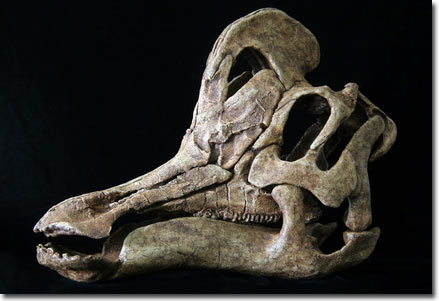Discovered a new giant duck-billed dinosaur in Mexico
According to scientists, a new crested duck-billed dinosaur was discovered in Mexico. The discovery of a 72-million-year-old fossil contributed to the diversity of dinosaurs that once lived in western North America during the later stages of the dinosaur era.
The new species was named Velafrons coahuilensis after the name of Coahuila state in north-central Mexico, where fossils were discovered. The length can be up to 10.5m, the newly discovered dinosaur is a herbivore of a group of duckbill dinosaurs hadrosaurs, living in the same area as carnivorous dinosaurs such as tyrannosaurs and velociraptors.
Terry Gates, an archaeologist at the Utah Museum of Natural History in Salt Lake City, said: 'The specimens of this dinosaur group belong to one of the most popular types discovered in Coahuila, supporting the hypothesis. Speculum dinosaurs are the favorite food of tyrannosaurs ".
This fossil consists of a skull almost complete with the crest bone on the forehead with a part of the skeleton. This species is still immature at the time of death and is about 7.5m long. Velafrons is the first case of crested duck-billed dinosaurs in this part of North America.
The findings are published in the December issue of the Journal of Vertebrate Paleontology .

The species Velafrons coahuilensis is determined by the skull and other fossil remains.(Photo: News.sawf.org)
Sea on land areas in the Americas
The record of Mexican dinosaurs is relatively rare - the newly discovered species is one of the country's first identified dinosaurs. But according to Scott Sampson, an archaeologist at the Utah Natural History Museum and co-author of the work, "Mexico, like other parts of western North America, is home to many diverse dinosaurs, from large to small. From tyrannosaurs predators (leading in predators) to horny or speculum herbivores, even smaller ones. '
At the end of the Cretaceous period about 72 million years ago, a warm and shallow sea divided North America into two land masses, one to the east and one to the west.
Mexico today used to be the southern tip of the mainland, shaped like a peninsula called Laramidia. The arid desert terrain, where dinosaurs were discovered in the early 90s, did not look like the wet estuary that existed 72 million years ago. Many dinosaur bones discovered in this area are buried with snails and clams, showing that these animals settle in environments near the coast.
Gates, the lead author of the study, said: 'The location is quite common in Coahuila, but we still try to understand why. Opening the door to the world of dinosaurs requires not only how it looks, but how it dies. Much of the work we will be doing in Mexico focuses on 'deciphering' the different bones discovered. '

Illustrating the species of Velafrons coahuilensis, a newly discovered crested duck-billed dinosaur in Mexico.(Photo: Thesun.co.uk)
Terrible storms
Scientists have discovered large bone groups including the skeleton of speculum and horned species. They said that terrible storms may have occasionally devastated this area and destroyed many dinosaurs.
A massive collection of dinosaur traces in this area shows that it used to be the home of many of the densest dinosaurs, perhaps the speculum, which according to scientists live concentrated in large groups.
However, the scientists added, many different dinosaurs seem to be not as widely dispersed as they expected.'Not long ago, we predicted that only about one dinosaur will be present in a small land mass - less than one fifth of North America's current area - but what is being discovered is different. surprising levels, with giant animals coexisting in relatively small areas. '
'In addition, there may be countless fast-evolving species - that is, species that appear and disappear at very fast speeds and have a process that lasts less than 1 million years.'
Relationship with Asia
Most species of hadrosaurs living in North America during this period were discovered in Alberta, Canada. Don Brinkman, of the Royal Tyrrell Paleontological Museum in Alberta, said: 'One of the things we're trying to find out is how Canadian dinosaur communities are different from those of Mexico.
Brinkman is researching non-dinosaur vertebrates found in Mexico.'With this finding, we begin to see dinosaurs living in these areas differently. Once we understand the patterns at a certain time, we hope to keep track of the pattern change with the changes in the weather. "
Philip Currie is an archaeologist at the University of Alberta in Edmonton. 'The description of the new crested hadrosaur is particularly interesting because it involves species in Canada and Asia, and will change some of our insights into the distribution of this species in the south.'
- Repeatedly discovered dinosaur fossils in Canada
- Detecting dinosaur footprint 70 million years old
- The largest fossil dinosaur skeleton discovered
- Detecting duckbill dinosaurs with 800 teeth
- Dinosaurs have orange skin?
- Strange duck-fossil dinosaur fossils with tumors on the face
- Detecting giant dinosaur tails dating back 72 million years
- Discovered a new giant dinosaur twice the size of an elephant
- Ingredients in the gut reveal the diet of dinosaurs
- Discover the most 'weird' duckbill dinosaur in history
- Feeding dinosaurs with milk?
- China: Digging soil to build, discovered a series of dinosaur eggs of 145 million years
 Discovered an ancient centipede fossil 99 million years old
Discovered an ancient centipede fossil 99 million years old Discovered bat-like dinosaurs in China
Discovered bat-like dinosaurs in China Discovered a 200-year-old bronze cannon of the coast
Discovered a 200-year-old bronze cannon of the coast Discover 305 million-year-old spider fossils
Discover 305 million-year-old spider fossils